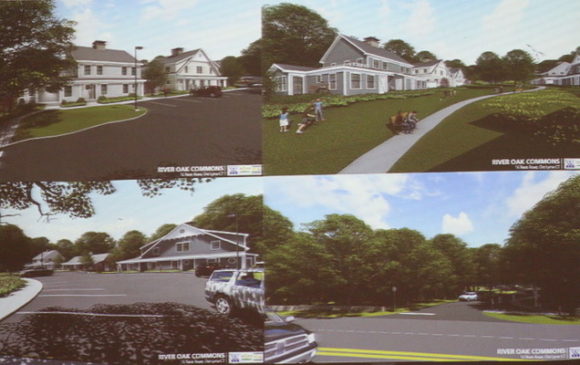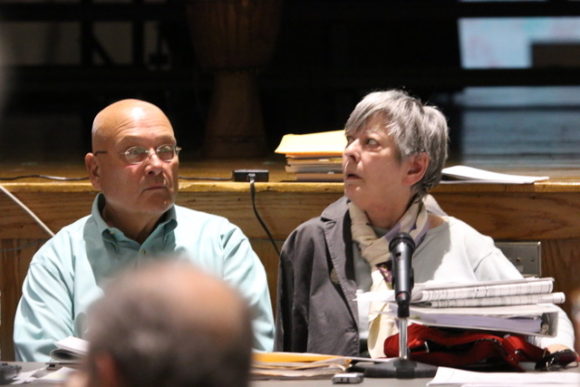
FULL REPORT NOW ADDED: More than 500 people — 503 to be precise according to Old Lyme Fire Marshal David Roberge, who counted them — turned out Tuesday night to attend the Old Lyme Zoning Commission’s Special Meeting held in the Lyme-Old Lyme Middle School (LOLMS) auditorium. The meeting was held to discuss the Affordable Housing proposals submitted by HOPE Partnership for 18-1 Neck Road (formerly 16 Neck Road) for a total of 37 dwelling units. The property, which will be known as River Oak Commons I and II, falls under Connecticut General Statutes 8-30g and is currently owned by Graybill Properties, LLC.
After various formalities including the call of the meeting and a listing of all the items on record in the file, the lawyer for the applicant, Attorney David Royston, summarized what would happen next. He said the applicant planned to make an at least hour-long presentation, during which he along with the applicant’s civil engineer, Joe Wren of Indigo Land Design of Old Saybrook; Lauren Ashe, Executive Director of HOPE, and John Cunningham, landscape architect for the project would all speak.
In addition, Royston said Stephen Ullman, a traffic engineer with over 39 years experience working in the field of traffic design, who was engaged to undertake a number of traffic studies on behalf of the applicant, and Greg Nucci of Point One Architects in Old Lyme, who is the lead architect for the development, would make presentations.
Noting that the development is intended for Connecticut residents defined by the acronym ALICE (Asset Limited, Income Constrained, Employed), Ashe maintained that these projects “will convert an underutilized area of land to a vibrant community for 37 families,” providing them with the “peace of mind of a safe, affordable place to live.” She also noted that the development will “fit into the tapestry of the neighborhood.”
Ashe said the development will meet the housing needs of people who earn between $22,000 approximately and $67,840. The area’s median income is $84,800 and the earnings parameters cited are respectively 25 and 80 percent of that median income. She named retail, food service, landscape and office workers; hairstylists; dental assistants; EMT personnel, and recent college graduates as possible fields of employment for potential affordable housing applicants. Ashe added pointedly that the state of Connecticut is “losing young people at the fastest rate in the nation.”

Ullman, pictured above, said he undertook the original traffic study for the applicant in December 2017. He followed up that survey with a second one over the 2018 Memorial Day holiday weekend and concluded, “Our opinion is this development will not adversely affect the traffic in the area.” He added that he had heard in the late morning of the presentation that the Connecticut Department of Transportation was not willing to change the Yield sign at the foot of the Exit 70 off-ramp to a Stop sign.
Commenting on the land on which the proposed development is planned, Wren stated, “The majority of the property has deep well-drained soil,” adding that, “We don’t expect much blasting.” He explained that the elevation of the site rises from 40 ft. above sea level at the street to 90 ft. at the highest point.
Wren said that seven and four multi-family residential buildings respectively would be constructed on River Oak Commons I and II, and that there would also be a community center. He noted that there will be one septic system for each building, making a total of 12 septic systems, and in terms of residential water supply, wells have been deemed “the best method to serve the project.” On the subject of fire prevention, Wren said recent legislative changes meant that the buildings comprising this project, “don’t need fire sprinklers.”

The landscape plan included new tree plantings, maintained lawns, ornamental trees, a non-maintained area and a plant list that was 99 percent native, but in his presentation, Cunningham noted, “A lot of existing material … won’t be removed.”
Architect Nucci showed a video that was intended to convey to the audience a three-dimensional impression of the development, saying, “I hope this gives a sense of community,” in which the buildings are not “the same” thus creating, “a village effect.” He stressed the high standard to which the buildings were being constructed in terms of such factors as insulation, HVAC, siding, roof shingles, lighting, noting the buildings were designed “to look like one home, but were actually divided into a number of different units.” These units are variously one-, two- or three-bedroom units.

Commission Chair Jane Cable, pictured above right, then opened the floor to questions from the commission members. Commenting that she had lived in Old Lyme all her life, Jane Marsh said she was familiar with the requirement for a 500 ft. sight line and therefore, “It still bothers” her that, “There is not 500 ft. between the foot of the ramp and the entry to River Oak Commons.” Loud applause erupted when she stated unequivocally, “You can’t see the car that hasn’t arrived.” Marsh added that her ”main concern” remains, “What’s happening for people waiting to turn left.”
Stacy Winchell challenged Ullman’s traffic study, which had excluded study of traffic on I-95, asking, “Why not look at I-95?” to which Ullman replied, sparking laughter throughout the auditorium, “What happens on I-95 stays on I-95.” Cable then explained to a bemused Ullman that she believed the concern being expressed was that “When an accident happens, people in River Oak Commons won’t be able to get out.” Ullman continued to maintain, “This development will not affect traffic on average days.”
Commenting that there is a sidewalk in the development down to Rte. 156 but no sidewalk beyond that to the Halls Rd. shopping center, Marsh asked, “Does anyone think a pedestrian will take their life in their hands and cross 156?”
Nucci clarified that it was anticipated that the sidewalk in the property would be used primarily by children going to their school buses. Marsh responded immediately that she hoped school buses would not be picking up at this point on Rte. 156.
When Cable opened the floor to public comment, after a question requesting the noise impact of I-95 on the development be studied, Chuck Hinckley of Lyme St. stated he and Old Lyme resident David Kelsey had hired their own lawyer to assist in analysis of the project proposal. Hinckley then submitted a six-page letter to the Commission detailing his concerns with the River Oak Commons proposal.
These included the fact that the attorney representing the applicant also frequently represents the Town in land use matters creating a possible conflict of interest leading to an appearance of impropiety, possible lead contamination of the soil, the grade of the driveway that might prevent a fire truck obtaining access to the development, and the absence of a Stop sign at the foot of the Exit 70 off-ramp. Hinckley conclude, “There’s no way this project can overcome these fatal flaws.”
Attorney Lew Wise of Rogin Nassau of Hartford, who had been hired by Hinckley and Kelsey, summarized his findings saying, “The public hasn’t received information [on the project] on a timely basis.” and “There are consequences of not following proper procedures.” He noted there was much missing information from the proposal such as a water supply plan, an analysis of the impact of the proposed well water system on neighboring wells, and a landscape plan, but noted some of these items had now been presented that evening. Although the Affordable Housing status allows a significantly less stringent level in the approvals process, Wise pointed out, “There is nothing in the Affordable Housing application that allows the applicant to have missing infomration.”
Wise urged the commission to “deny this (the current) application without prejudice so that it can be completed,” adding, “We should all be permitted to comment on the plans … the people of Old Lyme — the people here — are entitled to know that all aspects of the plan have been thoroughly studied.” He said that, “at this point,” this was not the case.

In contrast, Laura Fitzpatrick-Nager, Senior Associate Minister at First Congregational Church of Old Lyme, spoke in favor this “wonderful” project, noting that the congregational church supports the work of HOPE and its efforts to provide “first-rate affordable housing.” She commented, “I am dismayed by the overall tone of this meeting. I hope we don’t make Old Lyme a closed community but an open community.”
Greg Stroud, SECoast Executive Director, also stated that he is a strong supporter of affordable housing, and would like to see more affordable housing in Old Lyme, adding that he grew up in a poor urban area. He said that his organization would support or remain neutral about an affordable housing project in a different location in Old Lyme, citing Lyme Street and Hatchetts Hill Rd. as possibilities.
Stroud said he had met with HOPE and the Women’s Institute (with which HOPE is partnering on the River Oak Commons project) a month ago and raised SECoast’s major concerns regarding this proposal. These centered on two questions, “How can pedestrians get to Halls Rd.?” and “How can people turn left out of the project?” Stroud noted that traffic engineering expert Ullman had not mentioned the words, “left turn” nor “pedestrian” in his report. Moreover, despite Ullman’s extensive qualifications and a month’s notice, Ullman still had not given a response to Stroud’s questions, which led Stroud to say, “I think there’s a problem here.”
Concluding, “This site has fundamental problems,” Stroud added that he disagreed with the statement that sprinklers were not required. He said the requirement for sprinklers recently had, in fact, been approved but was then denied without prejudice. He stated that therefore, in his opinion, there was, “No sense that this requirement will disappear.”
Old Lyme resident Sloan Danenhower also questioned the location of the project, saying, “I am in favor of Affordable Housing but not at this location.”
The meeting was drawn to a rapid finish when LOLMS personnel indicated around 10:40 p.m. that the school needed to be closed. The commission quickly adjourned the meeting saying it would be continued to their regular meeting next Monday, June 11, at 7:30 p.m. when the application for River Oaks Common II would also be heard.
Editor’s Note (i): It has since been announced that Monday’s meeting will be held in the LOLMS auditorium.
Editor’s Note (ii): Visit this link to view a video (lasting three hours, six GB) courtesy of SECoast.org of the majority of the meeting: https://1drv.ms/v/s!AsFtT2rPsiyw2QWQQrNEYMy7uHj9
Here is a link to a 3-hour 6-GB video of the hearing. You might be able to stream it, but we suggest downloading and viewing it.
https://1drv.ms/v/s!AsFtT2rPsiyw2QWQQrNEYMy7uHj9